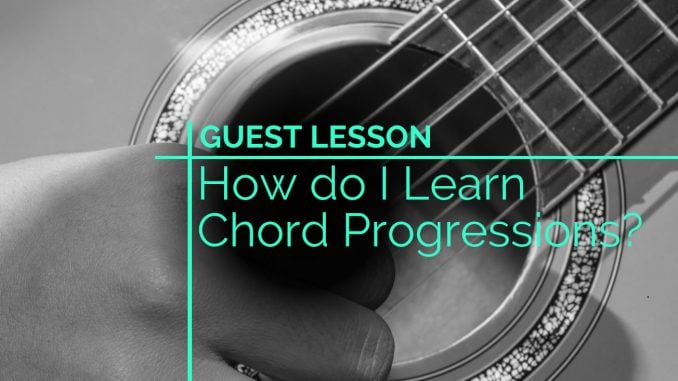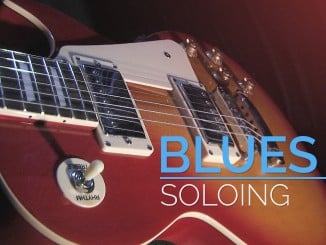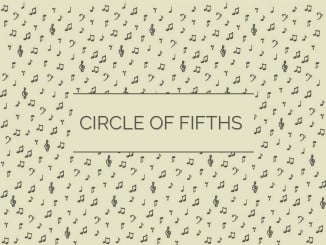
If you are here, it means you are interested in getting started with some chord progressions. You probably heard from a friend or teacher that you should start out learning the note names and perhaps a few little melodies. That is definitely how I learned, at least.
If you are ever on YouTube looking at guitar videos, you have probably seen any number of instructional videos talking about “secrets” or “tried and true methods”. While I am sure that some of these are very useful, I am also certain that some of these people are trying to overcharge you for very basic information! In the age of information, we have so many resources available to us. While this is a great thing, it comes at a cost. Lots of information is great, but we need it to be of good quality. I will not be claiming any perfect method here, but I will share with you what got me started and what worked or didn’t work for me.
For this lesson, I will not take much time discussing the theoretical aspects of building chords, scales, etc., but I do recommend that you get into this early in your playing career. Knowing the names for things means that you can communicate ideas to other musicians more easily and with more accuracy. You don’t want to be left trying to catch up later!
Reading Chord Diagrams
Before we continue, it is necessary that you are able to read chord charts, so we will discuss that briefly.
-Think of it as if you are holding up the guitar with the fretboard facing you
-Black marks are the frets that you will play
-Arcs or lines across several strings means that you will barre those notes
-A “0” above a string means that string is played open (without fretting)
-An “X” above a string means that string is muted entirely
Here is an example containing each of the elements listed above:

Most of the first open position chords we learn belong to the keys of G major and C major. For the purposes of this lesson, we will stick to those keys mostly. These shapes are movable if you are using a capo. You have probably seen this device before. It’s a clamp that attaches to the fretboard to change the key for you.
First Few Chords
Let’s start with a few chords. Now, I don’t really remember EXACTLY which four chords I learned first, but I would be willing to bet that it was these four or something close.




Posture and Form
The most important thing about playing these in the beginning is getting a good sound out of each note. It will always be difficult at first to avoid muted and unwanted notes, but this is all part of the process. Take your time with it and make sure you are getting a sound out of each note. To make sure you get the best out of each note, there are a few guidelines that might help you along the way.
- Sit up straight. It is very common for beginners to slouch and this makes your arms and wrists bend in all sorts of weird ways. Nip this habit in the bud early.
- Make sure you are using the tips of your fingers and avoid pressing the palm of your hand against the neck. I always tell my students to imagine that they are holding a tennis ball.
It might take you a good week or two to get a good sound out of each chord at first. This is perfectly normal. There is no rush. The most important thing is that you are getting a good sound out of the instrument.
Practicing Progressions
I am sure that people have different ways of teaching progressions, but this is the way I learned and I also find it to be rather effective. Simply take a metronome and set it to a slow tempo – something like 40-50 BPM – then practice two chords at a time. If that is still too fast, go even slower. Remember, there is no rush here!
As I was saying, take this two chords at a time.
Let’s use our first four chords. Begin by taking G and C and alternating between them to the metronome. Play each one four times before switching. Your practice would be something like “G G G G | C C C C | G G G G | C C C C |” and so on. Do this until you feel comfortable, then move on. Practice each pair like this until you feel comfortable with each transition.
The result would be something like G to C, C to Em, Em to Am, and Am to G. Once you feel comfortable with each transition, go ahead and try the whole progression using the same method.
It should look something like this:
| G G G G | C C C C | Em Em Em Em | Am Am Am Am |
…and repeat!
More Progressions
Now, we can add just a few more simple progressions to your arsenal.
- G – Em – Am – D
- C – Am – Dm – G
- Em – C – G – D
- Am – F – C – G
These are two very basic and VERY common progressions in two different keys (G and C). Make sure to use the same practice method when going over these. Take it slow and use a metronome! These two progressions have been in thousands of songs – literally.
Learn Songs
To conclude, I would like to discuss the benefit of learning popular songs. I cannot stress the importance of this enough. Going over scales, chords, and arpeggios is great, but the best way to absorb the stuff is to really see it in action. Learning songs will teach you new chord shapes, progressions, and more. You will also get a feel for how songs and progressions are constructed and, perhaps, even begin writing your own tunes. Composing music is very intrinsically rewarding and I would recommend it for anyone from beginner to professional!
About the Author
Marc-Andre Seguin is the webmaster, “brains behind” and teacher on JazzGuitarLessons.net, the #1 online resource for learning how to play jazz guitar. He draws from his experience both as a professional jazz guitarist and professional jazz teacher to help thousands of people from all around the world learn the craft of jazz guitar.





Thank you for providing such a great lesson. This is very motivating me to play.
Thank you for the kind words.